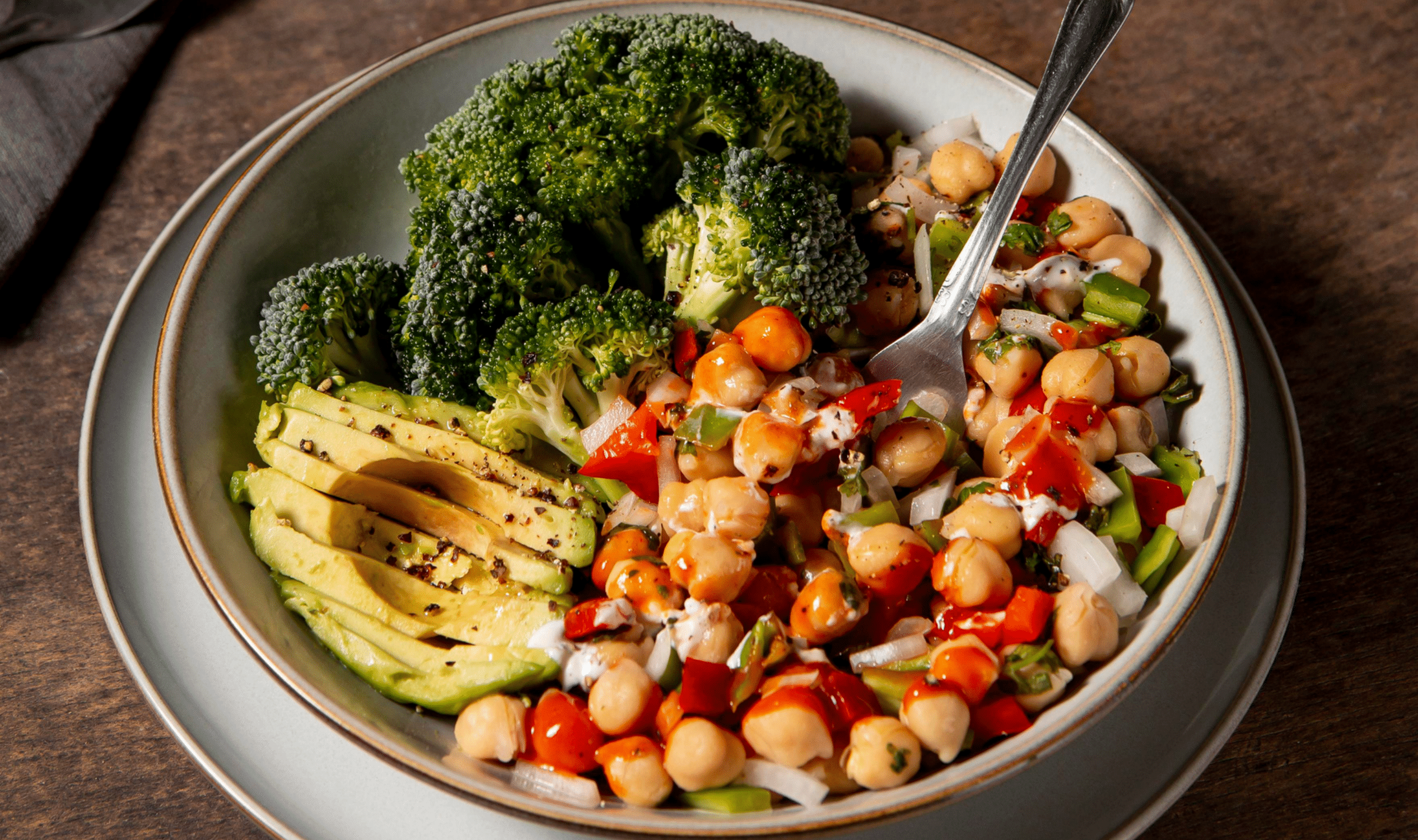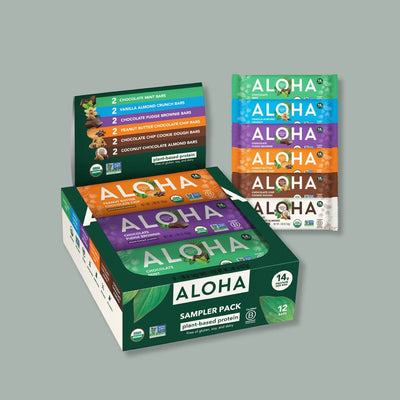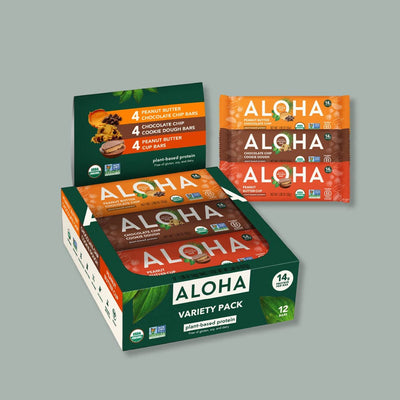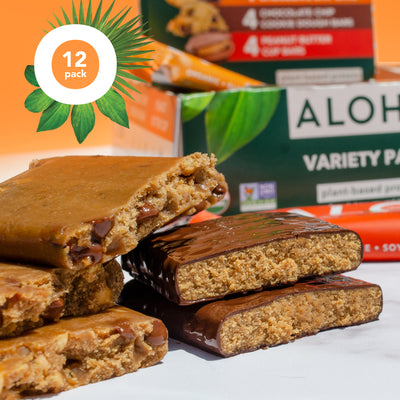Key Takeaways:
- Your Body Has Limits: Your body can efficiently absorb 20-30 grams of protein per meal, with excess often used for energy or stored as fat. Balance is critical to effective intake.
- Quality and Timing Matter: Choosing high-quality protein and spreading your intake across meals ensures consistent energy, muscle repair, and overall health benefits throughout the day.
- Plant-Based Protein Is Powerful: Plant-based protein sources, like ALOHA’s protein powders, are nutrient-packed, sustainable, and effective for meeting your body’s amino acid needs.
At ALOHA, we know the secret to making healthy choices is keeping them simple and approachable. With our organic, plant-based protein powders, we’re here to guide your wellness journey with products designed to fuel your body and fit into your lifestyle seamlessly. Think of us as the friend who cheers you on while keeping things down to earth.
How much protein can your body handle in one sitting? It’s a common curiosity for anyone looking to make their meals more purposeful. After all, understanding how your body processes nutrients is a vital part of building a sustainable wellness routine.
In this piece, we’ll explore the science of protein absorption and uncover the truth about how much your body can process at one time. We’ll keep it clear and practical so you can make confident choices that support your health goals.
Understanding Protein Absorption
Protein is more than just a nutrient—it’s your body’s go-to resource for building and repairing. When you consume protein, your digestive system breaks it into smaller units called amino acids. These amino acids are absorbed into your bloodstream and delivered wherever needed, whether rebuilding muscle after a workout or supporting everyday processes like immune function.
But here’s the catch: your body can only process a certain amount of protein at a time. The rest? It’s either used for energy or stored as fat—not exactly what you had in mind for your nutrient-packed meal. Understanding protein absorption is critical; it helps you make informed decisions about how much to eat and when so your body gets the most out of every bite.
How The Body Absorbs Protein
The protein absorption process is like a relay race, with each step building on the last to deliver nutrients where they’re needed most. It all starts in your stomach, where enzymes break down the protein into smaller molecules. From there, the action moves to your small intestine, where the magic happens: amino acids are absorbed into your bloodstream and sent off to support everything from muscle repair to hormone production.
What’s impressive is how efficiently your body prioritizes these amino acids. Muscles, tissues, and vital organs get first dibs, ensuring the essentials are covered. But remember, your body isn’t designed to store protein long-term, so excess amounts are either burned for energy or stored as fat—reinforcing the importance of consuming the right amount for your needs.
Factors Affecting Protein Absorption
Protein absorption is a dynamic process influenced by several personal and dietary factors. These factors can determine how well your body utilizes the protein you consume, making it essential to tailor your approach to your unique needs. Let’s break it down further:
- Age and Activity Level: Your age and activity level significantly influence protein absorption and utilization. Younger, more active individuals often have higher protein requirements because their bodies are in constant repair and growth mode. Older adults may also need more protein to counteract muscle loss, but their digestion may slow slightly, making the timing and quality of protein even more crucial.
- Type of Protein Consumed: Not all proteins are created equal. Like those in ALOHA’s protein powders, plant-based proteins often take longer to digest but come with added nutrients like fiber and antioxidants. Animal-based proteins may be absorbed faster, but plant-based options offer a more sustainable, nutrient-dense alternative that supports your overall wellness goals.
- Timing of Protein Intake: When you consume protein throughout the day, your body gets a steady supply of amino acids for repair and energy. Eating protein in smaller, consistent amounts helps prevent overload and improves absorption. This balanced approach allows your body to maximize the benefits of each meal without wasting excess protein.
-
Macronutrient Pairing: Pairing protein with healthy fats and carbohydrates can enhance digestion and nutrient uptake. For instance, combining ALOHA’s protein powder with a smoothie containing fruits and nut butter creates a balanced meal that supports energy and recovery. These macronutrient combinations improve the efficiency of protein absorption while adding variety to your diet.
Understanding these factors helps you optimize your protein intake for better absorption and overall health. By choosing high-quality proteins, timing your meals strategically, and pairing them with complementary nutrients, you can ensure your body gets the most out of every gram.
The Science Behind Protein Limits Per Meal
While it might seem like the more protein you consume, the better, your body has its limits. Research suggests that the human body can only efficiently absorb a certain amount of protein per meal, depending on individual factors. Let’s unpack the science behind these limits and how they apply to your daily routine:
The Absorption Cap
Most studies indicate that your body can effectively use around 20-30 grams of protein in one meal. Anything beyond that may not go to waste entirely but is often redirected for energy or stored as fat. This means it’s more effective to space your protein intake across meals rather than consume much at once.
Muscle Protein Synthesis (MPS)
Muscle protein synthesis (MPS) is the process where your body repairs and builds muscle tissue after it’s been broken down. MPS is stimulated most effectively with moderate doses of protein, roughly 20-25 grams per meal. Consuming more protein than this doesn’t necessarily enhance MPS further—it gives your body more to process.
Individual Variations
While the average absorption limit holds true for many, factors like body size, metabolism, and physical activity can slightly shift the number. Highly active individuals or athletes may benefit from a slightly higher protein intake per meal, but balance is key. Tailoring your intake to your needs ensures optimal results without overloading your system.
How Much Protein Can You Absorb In One Meal?
Understanding how much protein your body can handle in one meal helps you plan smarter, not harder. While the exact amount can vary between individuals, science provides a general guideline that works for most people. Let’s explore the details to help you make informed choices:
The General Rule Of Thumb
For the average person, 20-30 grams of protein per meal is the sweet spot for maximum absorption and utilization. This range ensures your body has enough amino acids to repair tissues and fuel essential functions without overwhelming your digestive system. Spreading your protein intake across several meals is the most effective way to build muscle or maintain energy.
Adjustments Based On Goals
Your personal goals can influence how much protein you should aim for in a single sitting. If you’re an athlete or engage in intense physical activity, slightly higher amounts (closer to 30 grams) may be beneficial to support recovery and muscle growth. On the other hand, sticking to moderate portions is plenty for general wellness and energy.
Why Timing Matters
Timing is critical in how effectively your body uses the protein you consume. Eating protein after exercise, for example, ensures your muscles have the amino acids they need for repair and recovery. Similarly, having protein-rich meals spaced evenly throughout the day keeps your body consistently fueled.
Maximizing Protein Intake For Optimal Health
Making the most of your protein intake isn’t about eating more—it’s about eating smarter. Focusing on quality, timing, and balance ensures your body gets what it needs to thrive. Here’s how you can optimize your protein intake for better results:
Focus On High-Quality Protein Sources
Choosing nutrient-dense, high-quality proteins is critical to getting the most out of your meals. Like ALOHA’s protein powders, plant-based options provide clean, organic ingredients that are easy to digest and packed with essential nutrients. These proteins are great for your body and align with a sustainable, eco-friendly lifestyle.
Balance Protein With Other Nutrients
Pairing protein with healthy fats and carbohydrates creates a balanced meal that supports digestion and energy. For instance, blending protein powder into a smoothie with avocado, oats, or fruits helps your body absorb nutrients more effectively. This approach also keeps your meals satisfying and flavorful, making it easier to stick to your goals.
Space Your Intake Throughout The Day
Rather than consuming large amounts of protein in one meal, aim to spread your intake across breakfast, lunch, dinner, and snacks. This ensures your body has a consistent supply of amino acids to repair tissues, support muscle growth, and maintain energy levels. Small, protein-rich meals can be the key to steady progress on your wellness journey.
Final Thoughts
Protein absorption is a fascinating interplay between science and individual needs, highlighting the importance of balance in nutrition. While the body’s capacity to process protein per meal has its limits, this doesn’t diminish protein’s vital role in muscle repair, energy production, and overall wellness. Instead, it underscores the value of making informed choices—ones that prioritize quality, timing, and personal goals.
Optimizing protein intake is less about adhering to rigid rules and more about embracing a mindful, tailored approach to your health. Whether you’re fueling post-workout recovery, sustaining energy throughout the day, or simply aiming for a balanced diet, understanding how your body processes protein empowers you to make choices that truly support your well-being.
Read also:
- Plant Based Diet vs. Vegan
- Mediterranean Diet vs. Vegan
- Holiday Snack Hacks: ALOHA Bars for Busy Days
Frequently Asked Questions About How Much Protein Can You Absorb In One Meal
Is there a universal limit for protein absorption per meal?
No, there isn’t a universal limit because protein absorption depends on factors like body size, metabolism, and activity level. However, most people efficiently absorb 20-30 grams per meal.
Can eating too much protein in one meal be harmful?
Eating excessive protein in one sitting isn’t harmful for most people, but unused protein may be stored as fat. Balance and moderation are key to avoiding digestive discomfort.
Does plant-based protein absorb differently than animal-based protein?
Plant-based proteins often take slightly longer to digest but are equally effective when consumed in adequate amounts. They also provide additional nutrients like fiber and antioxidants.
How does protein intake affect muscle recovery?
Protein provides the amino acids needed for muscle repair and growth after exercise. Consuming protein within 30 minutes to two hours post-workout can optimize recovery.
Can protein be absorbed more effectively with certain foods?
Yes, pairing protein with healthy fats or carbs can enhance digestion and nutrient absorption. A balanced meal helps your body process and use protein efficiently.
How many meals should I include protein in each day?
It’s best to include protein in every meal to maintain a steady supply of amino acids throughout the day. This supports muscle health, energy, and overall wellness.
Do protein powders work differently than whole food sources?
Protein powders are convenient and digest quickly, making them ideal for post-workout recovery. Whole food sources take longer to digest and provide additional nutrients.
How does hydration affect protein absorption?
Staying hydrated helps your digestive system function smoothly and aids in nutrient absorption, including protein. Drink water throughout the day to support your body’s processes.
Can I absorb more protein if I exercise regularly?
Yes, regular exercise can increase your body’s protein needs and ability to utilize protein effectively. Active individuals may benefit from higher protein intakes spread across meals.
Is protein absorption the same for everyone?
No, individual differences like genetics, digestion efficiency, and overall health impact how your body absorbs and uses protein. Personalized nutrition is essential for the best results.
Sources:
1. Schoenfeld, B. J., & Aragon, A. A. (2018). How much protein can the body use in a single meal for muscle-building? Implications for daily protein distribution. Journal of the International Society of Sports Nutrition, 15(1). https://doi.org/10.1186/s12970-018-0215-1
2. Jorn Trommelen, Glenn, Nyakayiru, J., Holwerda, A. M., Smeets, J. S. J., Hendriks, F. K., Kranenburg, van, Antoine, Senden, J. M., Goessens, J. P. B., Gijsen, A. P., & Loon, van. (2023). The anabolic response to protein ingestion during recovery from exercise has no upper limit in magnitude and duration in vivo in humans. Cell Reports Medicine, 4(12), 101324–101324. https://doi.org/10.1016/j.xcrm.2023.101324
3. Gilbert, J.-A. ., Bendsen, N. T., Tremblay, A., & Astrup, A. (2011). Effect of proteins from different sources on body composition. Nutrition, Metabolism and Cardiovascular Diseases, 21, B16–B31. https://doi.org/10.1016/j.numecd.2010.12.008
4. Moon, J., & Koh, G. (2020). Clinical Evidence and Mechanisms of High-Protein Diet-Induced Weight Loss. Journal of Obesity & Metabolic Syndrome, 29(3), 166–173. https://doi.org/10.7570/jomes20028
5. Gwin, J. A., Church, D. D., Wolfe, R. R., Ferrando, A. A., & Pasiakos, S. M. (2020). Muscle Protein Synthesis and Whole-Body Protein Turnover Responses to Ingesting Essential Amino Acids, Intact Protein, and Protein-Containing Mixed Meals with Considerations for Energy Deficit. Nutrients, 12(8), 2457. https://doi.org/10.3390/nu12082457
6. Atherton, P. J., & Smith, K. (2012). Muscle protein synthesis in response to nutrition and exercise. The Journal of Physiology, 590(5), 1049–1057. https://doi.org/10.1113/jphysiol.2011.225003
7. Witard, O. C., Jackman, S. R., Breen, L., Smith, K., Selby, A., & Tipton, K. D. (2013). Myofibrillar muscle protein synthesis rates subsequent to a meal in response to increasing doses of whey protein at rest and after resistance exercise. The American Journal of Clinical Nutrition, 99(1), 86–95. https://doi.org/10.3945/ajcn.112.055517
8. Cintineo, H. P., Arent, M. A., Antonio, J., & Arent, S. M. (2018). Effects of Protein Supplementation on Performance and Recovery in Resistance and Endurance Training. Frontiers in Nutrition, 5(83). https://doi.org/10.3389/fnut.2018.00083
ALOHA's products are not intended to treat, diagnose, mitigate, prevent, or cure disease. ALOHA's products should not replace prescribed medications or the variety of foods important to a healthful diet.
Do not self-diagnose any health condition. Work with your healthcare provider to determine how best to achieve optimal health.











